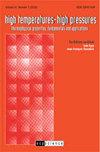石墨烯负载合成石墨/聚苯硫醚(PPS)复合材料的热力学性能
IF 0.6
4区 工程技术
Q4 Engineering
引用次数: 0
摘要
当热塑性塑料成为导热材料时,由于其低成本、轻量化和灵活性,在热管理应用中具有很大的潜力。本文以合成石墨和石墨烯为导热填料,制备高导热聚苯硫醚(PPS)基复合材料。采用双螺杆挤出机和注塑机制备了石墨烯和石墨添加PPS复合材料。通过几种表征方法,包括热重分析、差示扫描量热法、热力学分析、扫描电子显微镜、热扩散率测量、拉伸和弯曲测试,研究了复合材料的物理、热、力学和形态性能。石墨烯(5 wt. %)负载的合成石墨(40 wt. %)/PPS复合材料的面内和透面导热系数分别达到26.45 W/mK和5.02 W/mK。石墨烯负载的石墨/PPS复合材料具有出色的面内导热性,这是由于石墨烯和石墨填料的层状结构在流动方向上的对齐形成了有效的导热通道。本文章由计算机程序翻译,如有差异,请以英文原文为准。
Thermal and mechanical behavior of graphene loaded synthetic graphite/polyphenylene sulfide (PPS) composites
Thermoplastics when they become thermally conductive, have a great potential to be used in thermal management applications due to their low cost, lightweight, and flexibility. Here, synthetic graphite and graphene are used as thermally conductive fillers to fabricate Polyphenylene Sulfide- (PPS) based composite materials with high thermal conductivity. Graphene and graphite added PPS composites were manufactured by using a twinscrew extruder and injection molding machine. Physical, thermal, mechanical, and morphological properties of the composites were investigated by several characterization methods including thermogravimetric analysis, differential scanning calorimetry, thermomechanical analysis, scanning electron microscopy, thermal diffusivity measurement, and tensile and flexural tests, The in-plane and through-plane thermal conductivity coefficient of graphene (5 wt. %) loaded synthetic graphite (40 wt. %)/PPS composites are greatly improved to 26.45 and 5.02 W/mK, respectively compared to that of neat PPS. The outstanding in-plane thermal conductivity of graphene loaded graphite/PPS composites is attributed to the formation of an effective thermal conductive pathway due to the alignment of the layered structure of graphene and graphite fillers in the flow direction.
求助全文
通过发布文献求助,成功后即可免费获取论文全文。
去求助
来源期刊

High Temperatures-high Pressures
THERMODYNAMICS-MECHANICS
CiteScore
1.00
自引率
9.10%
发文量
6
期刊介绍:
High Temperatures – High Pressures (HTHP) is an international journal publishing original peer-reviewed papers devoted to experimental and theoretical studies on thermophysical properties of matter, as well as experimental and modelling solutions for applications where control of thermophysical properties is critical, e.g. additive manufacturing. These studies deal with thermodynamic, thermal, and mechanical behaviour of materials, including transport and radiative properties. The journal provides a platform for disseminating knowledge of thermophysical properties, their measurement, their applications, equipment and techniques. HTHP covers the thermophysical properties of gases, liquids, and solids at all temperatures and under all physical conditions, with special emphasis on matter and applications under extreme conditions, e.g. high temperatures and high pressures. Additionally, HTHP publishes authoritative reviews of advances in thermophysics research, critical compilations of existing data, new technology, and industrial applications, plus book reviews.
 求助内容:
求助内容: 应助结果提醒方式:
应助结果提醒方式:


